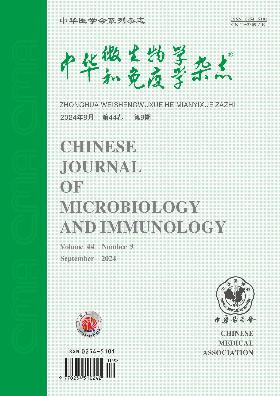In vitro antibacterial activity of triclosan in combination with different antibacterial agents against triclosan-resistant multidrug-resistant Acinetobacter baumannii
Q4 Immunology and Microbiology
引用次数: 0
Abstract
Objective To investigate the in vitro antibacterial activity of triclosan combined with different antibacterial agents against triclosan-resistant multidrug-resistant Acinetobacter baumannii (A.baumannii). Methods A total of 626 A. baumannii strains were collected from the First Affiliated Hospital of Wenzhou Medical University from 2016 to 2017. The sensitivity of these A. baumannii strains to common antibiotics was detected by VITEK 2-compact automatical microbiological analyzer and the minimum inhibitory concentrations (MIC) of triclosan were detected by agar dilution method. Checkerboard method was used to detect the changes in MIC values of triclosan against 16 triclosan-resistant multidrug-resistant A. baumannii strains after it was used in combination with four external ointments, including gentamicin, erythromycin, chloramphenicol and kanamycin, and three common antibiotics of imipenem, meropenem and ciprofloxacin, respectively. Fractional inhibitory concentration index (FICI) was used to evaluate the joint bacteriostatic effects. Results Among the 626 A. baumannii strains, 17 were resistant to triclosan with a drug resistance rate of 2.7% (17/626). These triclosan-resistant strains had high MIC values for ciprofloxacin, imipenem, ceftazidime and other commonly used clinical antibiotic and most of them were multidrug-resistant. After triclosan was used in combination with seven different antibacterial drugs, the MIC values of all drugs decreased to various degrees compared with those when they were used alone. Triclosan in combination with gentamicin, chloramphenicol and ciprofloxacin showed synergistic effects on 62.5%, 56.25% and 62.5% of the 16 strains and additive effects on 37.5%, 43.75% and 37.5%, respectively. When it was used in combination with erythromycin, kanamycin, imipenem and meropenem, synergistic effects on 37.5%, 25%, 12.5% and 12.5%, additive effects on 37.5%, 56.25%, 62.5% and 62.5%, and indifferent effects on 25%, 18.75%, 25% and 25% of the strains were detected, respectively. No antagonistic effect was found between triclosan and any of the above antibiotics. Conclusions Triclosan combined with gentamicin, chloramphenicol and ciprofloxacin had better in vitro antibacterial effects against the triclosan-resistant multidrug-resistant A. baumannii strains in this study with synergistic and additive effects. Some indifferent effects were found between triclosan and kanamycin, erythromycin, imipenem and meropenem, but no antagonistic effects were detected. Key words: Triclosan; Acinetobacter baumannii; Multidrug resistance; In vitro antibacterial activity; Drug combination三氯生联合不同抗菌剂对耐三氯生多重耐药鲍曼不动杆菌的体外抗菌活性
目的研究三氯生联合不同抗菌剂对三氯生耐药多药鲍曼不动杆菌的体外抗菌活性。用VITEK-2型全自动微生物分析仪检测这些鲍曼不动杆菌菌株对常用抗生素的敏感性,用琼脂稀释法检测三氯生的最低抑菌浓度(MIC)。采用棋盘格法检测了三氯生与庆大霉素、红霉素、氯霉素、卡那霉素四种外用软膏及亚胺培南、美罗培南、环丙沙星三种常用抗生素联合使用后,对16株三氯生耐药、多重耐药鲍曼不动杆菌MIC值的变化。采用部分抑菌浓度指数(FICI)评价联合抑菌效果。结果626株鲍曼不动杆菌中,17株对三氯生耐药,耐药率为2.7%(17/626)。这些三氯生耐药菌株对环丙沙星、亚胺培南、头孢他啶等临床常用抗生素具有较高的MIC值,且多药耐药。三氯生与七种不同的抗菌药物联合使用后,所有药物的MIC值与单独使用时相比都有不同程度的下降。三氯生联合庆大霉素、氯霉素和环丙沙星对16株菌株的增效作用分别为62.5%、56.25%和62.5%,对37.5%、43.75%和37.5%具有加性作用。与红霉素、卡那霉素、亚胺培南和美罗培南联合使用时,分别对37.5%、25%、12.5%和12.5%的菌株有协同作用,对37.5%和56.25%、62.5%和62.5%的菌株有相加作用,对25%、18.75%、25%和25%的菌株有不同作用。三氯生与上述任何一种抗生素均未发现拮抗作用。结论三氯生联合庆大霉素、氯霉素和环丙沙星对三氯生耐药多重耐药鲍曼不动杆菌具有较好的体外抗菌效果,具有协同和相加作用。三氯生与卡那霉素、红霉素、亚胺培南和美罗培南之间有一定的拮抗作用,但未发现拮抗作用。关键词:三氯生;鲍曼不动杆菌;多药耐药性;体外抗菌活性;药物组合
本文章由计算机程序翻译,如有差异,请以英文原文为准。
求助全文
约1分钟内获得全文
求助全文
来源期刊

中华微生物学和免疫学杂志
Immunology and Microbiology-Virology
CiteScore
0.50
自引率
0.00%
发文量
6906
期刊介绍:
Chinese Journal of Microbiology and Immunology established in 1981. It is one of the series of journal sponsored by Chinese Medical Association. The aim of this journal is to spread and exchange the scientific achievements and practical experience in order to promote the development of medical microbiology and immunology. Its main contents comprise academic thesis, brief reports, reviews, summaries, news of meetings, book reviews and trends of home and abroad in this field. The distinguishing feature of the journal is to give the priority to the reports on the research of basic theory, and take account of the reports on clinical and practical skills.
 求助内容:
求助内容: 应助结果提醒方式:
应助结果提醒方式:


